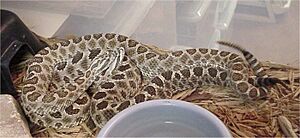Desert massasauga facts for kids
Quick facts for kids Sistrurus catenatus edwardsii |
|
|---|---|
 |
|
| Scientific classification |
|
| Kingdom: | Animalia |
| Phylum: | Chordata |
| Class: | Reptilia |
| Order: | Squamata |
| Suborder: | Serpentes |
| Family: | Viperidae |
| Genus: | Sistrurus |
| Species: | |
| Subspecies: |
S. c. edwardsii
|
| Trinomial name | |
| Sistrurus catenatus edwardsii (Baird & Girard, 1853)
|
|
| Synonyms | |
|
|
The Desert Massasauga (scientific name: Sistrurus catenatus edwardsii) is a type of venomous pit viper. It is also known as Edward's Massasauga or Edward's Rattlesnake. This snake belongs to the Viperidae family.
This subspecies of snake lives only in certain areas. You can find it in the southwestern United States and northern Mexico. Sometimes, its home range overlaps with another similar snake, S. c. tergeminus. When their ranges overlap, these two types of snakes can sometimes breed together.
Contents
What's in a Name?
The second part of the snake's scientific name, edwardsii, honors a person. It was named after Colonel Dr. Lewis A. Edwards. He was a U.S. Army surgeon who lived from 1824 to 1877. He was the one who first collected a sample of this snake.
How to Identify a Desert Massasauga
The Desert Massasauga is a slender snake. It is also smaller than its close relative, S. c. tergeminus. The longest recorded Desert Massasauga was about 53 centimeters (21 inches) long. This measurement includes its tail.
Its body color is usually light gray or white. It has dark gray or gray-brown blotches (spots) on its back. A special feature is a dark stripe. This stripe runs along the side of its head and goes right over its eye.
The rattle of this snake makes a very high-pitched sound. It is much higher than the rattles of bigger rattlesnakes. Because of this, some people call it a "buzztail."
Compared to S. c. tergeminus, the Desert Massasauga is lighter in color. Its belly is almost white. It also has fewer rows of scales around its middle. It has 23 rows instead of 25. It also has fewer scales on its belly and fewer blotches on its back.
Where Do They Live?
You can find the Desert Massasauga in several places. These include extreme southeastern Arizona and central and southern New Mexico. They also live in West Texas, reaching as far north and east as the Colorado River. They are found in the Lower Rio Grande Valley and many Gulf Coast counties. This includes areas as far north as Brazoria. They also live on some barrier islands, like North Padre Island, Matagorda Island, and San José Island. There are also some groups of these snakes in northeastern Mexico.
What Kind of Home Do They Like?
Desert Massasaugas mostly live in rocky areas. These areas are often dry or semi-dry. According to a scientist named Conant (in 1975), they are usually found in desert grasslands.
Daily Life of a Desert Massasauga
These snakes are mostly nocturnal. This means they are active at night. This is especially true during the summer. The weather is too hot for them to be active during the day. However, they sometimes come out to warm up in the sun. This is called basking.
What Do They Eat?
The Desert Massasauga's diet mainly includes small animals. They eat rodents, lizards, and frogs.
About Their Venom
The venom of a Massasauga snake is very strong. Drop for drop, it is more powerful than the venom of many larger rattlesnakes. However, they deliver a smaller amount of venom in one bite. This means the harm they can cause is less severe. Their bite is not usually deadly.
The venom is a powerful cytotoxic venom. This means it can damage cells and tissues. A bite can cause swelling, tissue damage, skin damage, and a lot of pain. If someone is bitten by a venomous snake, they should get medical help right away. There is an antivenin called CroFab. It can be used to treat serious Massasauga bites.
Conservation Status
The Desert Massasauga is a "species of concern" in Colorado. This is because there are not many of them in that state. Arizona state law also protects them. The United States Forest Service lists it as a sensitive species. This means they are watching it closely to make sure its numbers do not drop too low.
Images for kids



